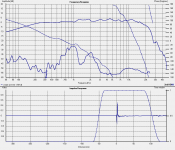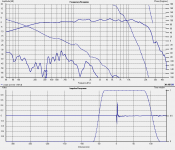Then there are those who can detect differences in DBT's and ARE able to detect differences in various tweaks....
Cite?
Would a valid subjective/objective trial be to take 1000 subjects, find the 80 or so who can tell the difference, and use them as the DBT group for a more accurate assessment of things audio? Or was the sample group sufficiently large in Toole and Olive's study?
In many of these studies, including Toole & Olive's, something similar was done, as it helped them get better/more valid results.
dave
There is of course no way to calibrate individual opinions and prefrerences, which is what makes them useles. And I didn't know that "accuracy" differed from place to place.
Given that loudspeakers are so bad (all of them even the best, i like to think maybe 10% of where they need to be, i am sure there is lots of room to argue that figure), that you can have 2 equally valid loudspeakers that sound completely different.
dave
is the accuracy being discussed here?
here is my (err, actually borrowed) 2c:
Unbiased listeners have no difficulty recognizing accurate sound reproduction, even with hearing damage or with hearing aids
Anyone wants to know what sounds better? Anyone needs an objective test of overall accuracy?
I say - ask Your wife/girlfriend!
uninterested and unbiased and at the same time women generally have better sense of hearing!
best
graaf
here is my (err, actually borrowed) 2c:
Unbiased listeners have no difficulty recognizing accurate sound reproduction, even with hearing damage or with hearing aids
Anyone wants to know what sounds better? Anyone needs an objective test of overall accuracy?
I say - ask Your wife/girlfriend!
uninterested and unbiased and at the same time women generally have better sense of hearing!
best
graaf
Given that loudspeakers are so bad (all of them even the best, i like to think maybe 10% of where they need to be, i am sure there is lots of room to argue that figure), that you can have 2 equally valid loudspeakers that sound completely different.
dave
This might be true is the number is 10%, but I don't accept that number. I think that its more like 80 - 90% in whcih case two loudspeakers at that level will likely sound surprising similar. Thats certainly been my experince.
uninterested and unbiased and at the same time women generally have better sense of hearing!
best
graaf
My wife is generally uninterested and as such pretty well unbiased. This helps in many regards, but in other ways the disinterest makes her imune to some effects which I hear and she doesn't. Bias is such a strong aspect that elliminating it alone yields a dramatic improvment in judgement, but it doesn't go much further than that when the lack of bias is a result of disinterest.
This might be true is the number is 10%, but I don't accept that number. I think that its more like 80 - 90% in whcih case two loudspeakers at that level will likely sound surprising similar. Thats certainly been my experince.
Only time will tell who has a closer guess...
dave
Cite?
I cited the same number of references you did in your post which I referenced - none..... So why should I have to?
It's not. What goes in is what comes out.
Rob
What goes in are electrons. What comes out are sound waves. It's a transducer and both microphones and loudspeakers are not very good transducers. Thus, both the front and back end of the audio chain are the problem areas where non-linear problems of sound detection and transmision raise their ugly heads.
I think that its more like 80 - 90%
Hard to justify that kind of number when amplifiers probably aren't that good.
dave
I cited the same number of references you did in your post which I referenced - none..... So why should I have to?
You don't have to do anything. Of course, the conclusion is, you're making that up.
I've described my experience with data compression tests in some other threads. To recap briefly, the same song was recorded using different data compression algorithms, from MP3 to bit-perfect (janneman would have to tell you what they were, this was done in his living room, the acronyms meant nothing to me), then the order randomized. They were then played and the test subjects had to order them. Equipment used was some sort of portable CD player and Stax headphones. The photo at the head of the RIAA article was me during that test, so you can see what model headphones they were. The answers were entered on a score sheet, then compared with a key at a later time when I wasn't there.
Frankly, it wasn't that hard to distinguish the various coding schemes. And I have certainly avoided MP3 ever since!
If someone wishes to satisfy a different group of customers, is there anything wrong with that? It's like those Prada, Gucci, Armani things, and in automobiles as well. There will be people that see value in these, and those that don't. So what. I think we should respect those with different values and priorities if they can afford it. A friend tells me that he used to see the same Rolls go into maintenance about once a week.OH, yeah, we're going to get somewhere with hearsay innuendo here?
Generally speaking, mainstream manufacturers are in large part "with the program," and the "my way" fringe relegated to $10,000+ boutique niche designs.
[Many of which measure poorly with respect to the T&O metric....]
Hard to justify that kind of number when amplifiers probably aren't that good.
dave
You are joking of course. Any good amp is 100%, only a broken one would be less than this. If an amp in "inaudible" how can it not be 100%? ANd DBT have consistantly shown amps to be inaudible.
I think this comment belongs over with the wire discussion.
If someone wishes to satisfy a different group of customers, is there anything wrong with that?
There is nothing "worng" with it so long as you realize it is "boutique" and NOT Hi-Fi.
You are joking of course. Any good amp is 100%, only a broken one would be less than this. If an amp in "inaudible" how can it not be 100%? ANd DBT have consistantly shown amps to be inaudible.
Not worth responding too...
dave
Nope, nothing.If someone wishes to satisfy a different group of customers, is there anything wrong with that?
I suppose there's a legitimate sense in which, in building to our individual tastes and preferences, DIY is "boutique," but there's certainly a greater likelihood of success, statistically, in pursuing known standards of excellence in performance as opposed to sticking random drivers in a box and pretending the result is what you like....

Last edited:
Sure, they call them Hi END.There is nothing "worng" with it so long as you realize it is "boutique" and NOT Hi-Fi.
Have you ever setup a system that has amps with the driving power for 120db at listening position? The effects of room reflection on distortion? The list goes on. The fact is a large portion of measurements are valuable for finding areas to improve rather than being the final arbiter of fidelity. Sure, if we follow some criteria based on measurements, there is less chance of going astray, and that is what those criteria are for. It's like, if you go through the educational system, chances of making a good living are much better than not having the basic education.Nope, nothing.
I suppose there's a legitimate sense in which, in building to our individual tastes and preferences, DIY is "boutique," but there's certainly a greater likelihood of success, statistically, in pursuing known standards of excellence in performance as opposed to sticking random drivers in a box and pretending the result is what you like....
And, as pointed out, I am careful not to say that distortion in a loudspeaker cannot be audible, it can. I am saying two things 1) THD and IMD are meaningless numbers even if the distortion is audible and 2) in a decent loudspeaker system design the nonlinearities are such that audibility is not an issue. It CAN BE if the system is poorly designed, and lest face it a whole lot of them are. But does a plot of THD versus frequency of a driver tell us anything? - No, not much at all. Individual orders above fourth or fifth "might be" meaningful (this has never been quantified), but a simple test will show that these orders are difficult to impossible to measure reliably because they are generall so low. 2nd and third order are irrelavent, and fourth and maybe fifth not very important. The haigher orders are very hard for a loudspeaker to generate because it is a massive mechanical system and these orders require a lot of force.
Hi Earl,
I have no problem with what you are saying here, but at what point do you classify the system as poorly designed (ie the distortion is just TOO high). I would imagine that there comes a point where second and third harmonic distortion really do become quite objectionable. Though I suspect this point will vary from person to person, going on my experience of hearing cheap systems overdriven and producing absolutely horribly distorted sound which I couldn't stand to listen to, but the owners were quite content!! I realise this example is likely more amp clipping than the speaker, which as you pointed out DOES produce objectionable high order harmonics much more easily than a speaker can on it's own.
Reason I'm asking is because I felt that I could hear some distortion in my new speakers (work in progress), only on certain music or voices. I did a swept sine measurement in holm impulse and whilst it says THD, and all orders though 10th are OK the actual figure for 2nd was quite a high result (to my untrained eye). Basically the peak level was about 5% between 700 and 1000 Hz.
Would that be considered broken/poor design... At what level would you start to be concerned. It is of course possible that there is a psycho acoustic effect going on here that because I'm aware of it, it makes it seem worse. I also can't rule out that the distortion isn't coming from somewhere else, eg my amp not coping too well with the relatively low impedance of these speakers, or my mic or mic preamp having a problem in that freq range.
Sorry this isn't meant to be a thread jack, but I think the question of what point is there a problem with the design is relevant to the topic, as identifying such design flaws is I guess one of the points of doing measurements
cheers,
Tony.
Attachments
There are also fundamentals, and as Toole states in that paper, a simple on-axis amplitude response would separate the groups in his study.Have you ever setup a system that has amps with the driving power for 120db at listening position? The effects of room reflection on distortion? The list goes on. The fact is a large portion of measurements are valuable for finding areas to improve rather than being the final arbiter of fidelity.
Voecks puts it this way: while meeting the metric does not guarantee an outstanding loudspeaker, it typically makes for a very good one, and no speaker that performs poorly in the technical measurements will ever pass muster in comparative listening tests.
That doesn't mean that, with sufficient hype, it can't be sold to the gullible (the "every seat" thing), but ultimately, the truth will out....
Last edited:
- Status
- This old topic is closed. If you want to reopen this topic, contact a moderator using the "Report Post" button.
- Home
- Loudspeakers
- Multi-Way
- Measurements: When, What, How, Why

